
About This Quiz
In the modern era of sleek emblems, it's easy to forget that hood ornaments used to be the epitome of style and luxury. In fact, many of the mascots that adorned car hoods in the '40s, '50s and '60s would fit right in with the displays in an art museum. Created by iconic artists and legendary carmakers, thee metal statues became the signature of many major automotive brands of the period, only to fall out of favor by the latter decades of the 20th century.Â
The first hood ornaments were created to serve a practical function. At a time when cars were prone to overheating, a temperature gauge installed above the radiator cap helped keep vehicles running smoothly. Throughout the 1920s, these practical caps and gauges quickly evolved into stylish figurines designed to draw the attention and admiration of onlookers. Ornaments from the '20s and '30s were inspired mainly by animals and classic mythology. Future decades brought shapely chrome curves, art deco designs and plenty of ornaments in the form of ships, trains, jets and rockets.Â
A trend toward sportier styles in the '60s, combined with the gas shortages of the '70s, mostly spelled the end for elaborate ornaments, which increased wind resistance and cut down on fuel economy. It was also during this period that many people began to realize that while hood ornaments might look cool, they could be deadly for pedestrians. Though ornaments have mostly fallen out of favor, many older examples are so iconic, they loom large in the minds of car buffs to this day. See how many you can name with this quiz!
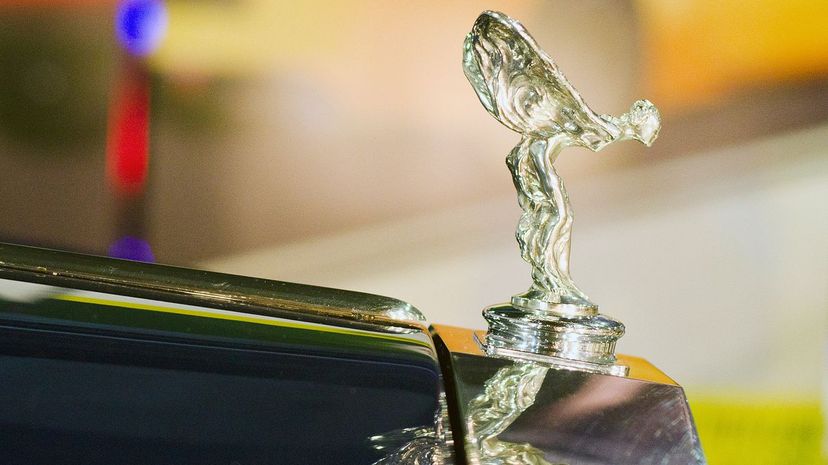
One of the most famous hood ornaments ever made, the Spirit of Ecstasy has adorned Rolls Royce luxury cars since the 1920s. The design of a woman bending forward at the waist, hair and clothes billowing in the wind, was commissioned by British politician Baron John Montague. His secretary - and secret lover - served as the artist's model for the figure. The figure has gotten smaller over the years, and it now recesses into the hood for safety and security when the car is parked.

Pontiac cars were named for a famous indigenous tribal leader from 18th century Ottawa, so it's no surprise that the company long used a stylized "Indian" Chief head as a mascot on its cars. Appearing for more than three decades, the most impressive versions of the Chief could be seen in the early '50s, when they were made of amber-colored Bakelite that glowed and sparkled in the sun.

Nash wasn't afraid to push the envelope with its use of the Flying Lady hood ornament in the '50s. Designed by pinup artist George Petty, the design featured a curvy woman stretched out face-down on the car's hood as though sunbathing. It was used on various Airflyte series cars in the post-war years, including the Metropolitan and Ambassador.
Advertisement

Military-inspired hood ornaments were all the rage in the '40s, and Buick's Bombsight was right on trend. Introduced in 1938, the chrome-plated bomb and crosshairs design became standard in the mid-'40s and was replaced by a more contemporary design the following decade.

This delicate bird with its long neck and stretched wings first appeared on Packard models in 1932, replacing the company's original logo - the family coat of arms. While initially called a pelican, Packard began referring to the bird as a cormorant in 1939. So many people wrote letters to complain that the company went back to the pelican name by the early '50s.

Buyers willing to shell out for a Bentley Model 8 Liter in the 1930s could choose to pay a little extra to add the company's Flying B hood ornament. Within a few years, the ornament came standard, though it was eventually flattened into an emblem rather than a stand-up design. The classic vertical profile returned in 2019 with the company's Flying Spur model. For safety and security, the B uses a sensor to detect when the driver is near, then automatically brings the classic ornament up from a concealed compartment.
Advertisement

The star of the 1939 World's Fair was a pair of buildings known as the Trylon and the Perisphere. This combination of a towering spire and smooth sphere inspired the chrome lance and golden sphere ornament on the hood of early '40s Lincoln Continental cars. The company used this silver and gold pairing on a variety of similar art deco ornaments throughout the rest of the decade.

Mack trucks performed so well on the battlefields of WWI that soldiers nicknamed them bulldogs. The company began using a bulldog mascot as a hood ornament - and a functional handle for lifting the hood - in 1932. The iconic Mack bulldog continues to top the company's trucks to this day.

Jaguar traces its roots to 1922 when it incorporated as the Swallow Sidecar Company. By WWII, it seemed like a good idea to drop the "SS" mascot from their cars to avoid association with the Nazi party. The company began using its legendary Leaper ornament in 1945, and the chrome-plated jaguar in flight remains a symbol of the brand to this day.
Advertisement

Ettore Bugatti used a hefty dancing elephant cast in silver to adorn his sporty Type 41 Royale. The mascot had been designed by Bugatti's brother, Rembrandt, who had committed suicide, prompting Ettore to use the image in his honor.
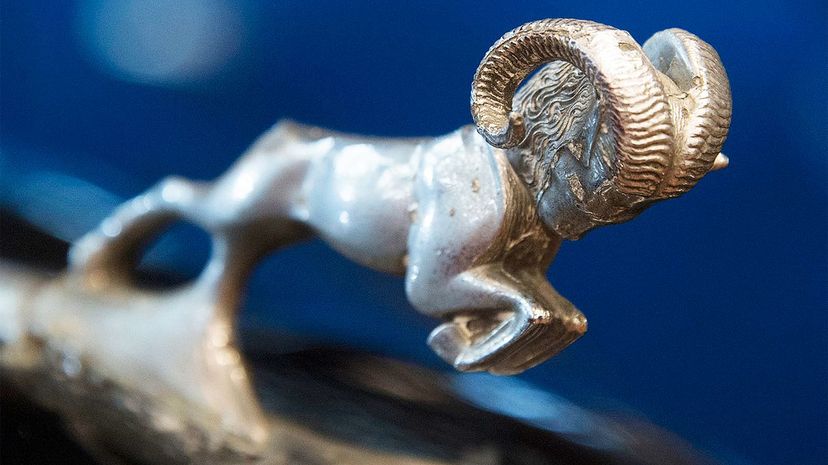
Dodge added various incarnations of the ram mascot as a hood ornament on its trucks between 1932 and 1954. The animal was replaced by other designs before Dodge brought it back in the '80s. When the Ram line was spun-off into its own brand in 2011, the mascot was used to create badges and emblems for these new tough trucks.

Packard channeled some of the elegant hood ornament designs of the '20s and early '30s with this iconic Goddess of Speed mascot. Introduced in 1938 and inspired by the goddess Nike, the hood ornament shows a female figure with arms outstretched, fingers cradling a tire as her hair and clothes blow in the wind.
Advertisement

Animal hood ornaments were huge in the '20s and '30s, so it's no surprise that Edsel Ford commissioned this racing greyhound statue to appear on early Lincoln models. It later showed up on the Ford Model 48, and may have served as an influence for the jaguar and ram mascots that came later.

La Cigogne Volante, or the Flying Stork, appeared on Hispano-Suiza cars beginning in the period between the wars. The company was inspired by WWI flying ace Georges Guynemer, whose fighter plane was decorated with the image of a stork, when choosing this hood ornament.

Airplanes were a huge trend for hood ornament designs in the '50s, so it's no surprise that Chevy got in on the action when designing its full-size Bel Air. The Detroit automaker took the trend to a new level with its jet bird mascot, which showed up on the Bel Air and other models from around 1954 through 1956. The ornament resembled a plane at first glance, but a closer look revealed an eagle-like head and beak instead of a traditional jet plane nose.
Advertisement

More than a century ago, leaders at Mercedes chose a three-pointed star to represent the company, with the three points in the image symbolizing the brand's dominance at land, by sea and in the air. It first appeared as a standup hood ornament in 1921 and was later combined with the Benz laurel wreath as the two high-end names joined forces.

The popularity of acrylic Lucite jewelry and household products exploded in the '40s and '50s. Ford took advantage of this material when crafting hood ornaments for its 1949 Custom and Deluxe cars, which were also known as "Shoeboxes" because of their pontoon styling. The modern, eye-catching combination of a chrome ball surrounded by a Lucite quarter-circle was just the right choice for the first completely new car model to come out of Detroit in the post-war period.

Chrysler chose Spanish explorer Hernando DeSoto as the mascot for its lower-priced line of cars. While the ornaments on early DeSoto models in the '30s and '40s largely took the form of traditional winged women or locomotives, the company used an image of DeSoto's own face on its 1951 Deluxe models. While chrome was the traditional finish, you can also find versions cast in amber-colored Lucite for added visual appeal.
Advertisement

AMC introduced its sleek Marlin Fastback in '65 to keep up with the Ford Mustang and other popular pony cars of the period. The pillarless roof and roomy interior of the Marlin balanced comfort and style in a whole new way. The car also featured an innovative hood ornament in the form of a flying fish image centered on a swirling, ocean-colored badge.
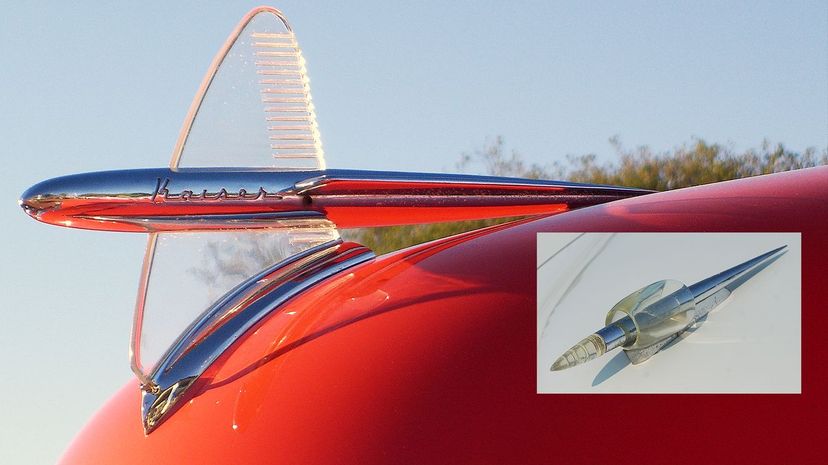
It would be hard to create a list of the deadliest hood ornaments in history without including the spears used by Kaiser in the late '40s and early '50s. While the '49 Virginian came with a relatively gentle rocket ornament featuring a plastic ring around the tip, the company's '51 hardtops had a hood ornament that was basically the equivalent of sticking a sharpened sword over the grille. Things only improved a tiny bit by 1953, when the Kaiser Dragon came with a plane-like ornament that was similar to a ballpoint pen with a pair of wings.

The hood ornaments that appeared on the Oldsmobile 88 between 1950 and 1955 were some of the finest examples of rocket-inspired sculptures you'll ever see. Sleek, modern and huge, these shiny chrome rockets gave the car a futuristic appeal that was just right to usher consumers into the second half of the 20th century.
Advertisement

After years of using stylized "S" designs and the standard airplanes, bullets and bullseyes found on many cars in the early 20th century, Studebaker tried something totally new on the 1962 and '63 Lark compacts. One of the first American compacts to find success with consumers, the Lark featured a simple reflector-style hood ornament. While it may not look all that unusual to modern car buyers, it was a big departure from the more elaborate emblems of the period.

The thick, stocky hood ornament on the 1953 and '54 Chrysler Imperial is impressive not only for its eagle design, but also for its significant heft and size. Despite drawing its inspiration from the graceful eagle, the ornament consisted of sharp edges and straight lines rather than any gentle curves or delicate wings.
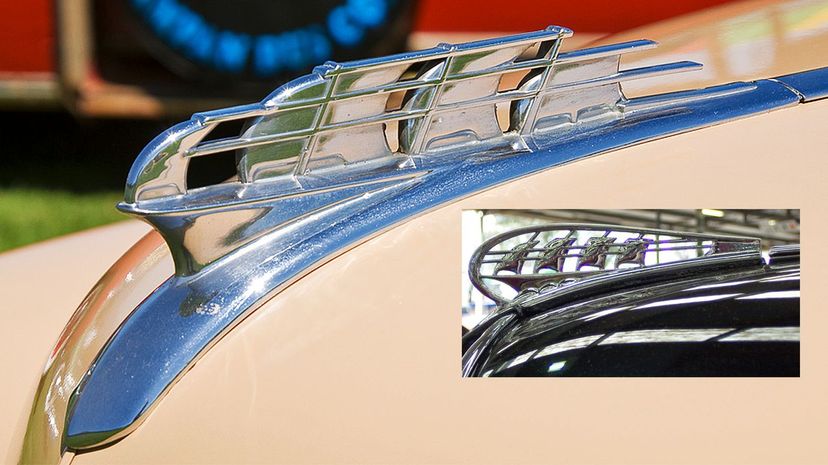
Plymouth faithfully used the Pilgrims' Mayflower sailing ship as the inspiration for its hood ornaments through the '50s, when they switched to a Pentastar emblem. What's most interesting about Plymouth's hood ornaments is how they changed the Mayflower design based on automotive trends, even incorporating art deco styling and trains in the '30s and '40s, then combining the ship with a locomotive or a plane in later decades.
Advertisement

The high-end nameplate of the GM line since 1902, Cadillac began using its iconic Winged Woman mascot in the '30s. The earliest models were fine and delicate, but by 1941, the ornament was much more elaborate and detailed, with the figure now positioned head down to emphasize speed. By the '50s, the design had changed to accommodate the airplane trends of the period, and the woman's original figure had nearly disappeared.

In the late '40s, Chevy took advantage of increased availability of plastic and synthetics to craft new and eye-catching hood ornaments. Many Fleetmaster and Fleetline models of the period came with chrome, rocket-inspired sculptures on the hood, but the company also offered the option of red, green, amber and other colors not commonly found in hood ornaments.

Detroit-based Hudson Motors was ahead of its time with the 1930s Terraplane. These surprisingly powerful sedans, coupes and convertibles combined bright red plastic materials with shiny chrome to craft some of the most memorable hood ornaments of the period. Particularly impressive are the 1935-1937 designs, which consist of colorful plastic rockets wrapped in chrome casing.
Advertisement

Did you know British automaker Austin produced the FX3 and FX4 cars that served as the traditional British taxis for decades? While these black taxis had relatively simple hood ornaments, Austin's passenger cars of the '40s and '50s typically featured the Flying A logo, a smooth and stylish letter A complete with a pair of wings - and a design a whole lot like Bentley's Flying B mascot.
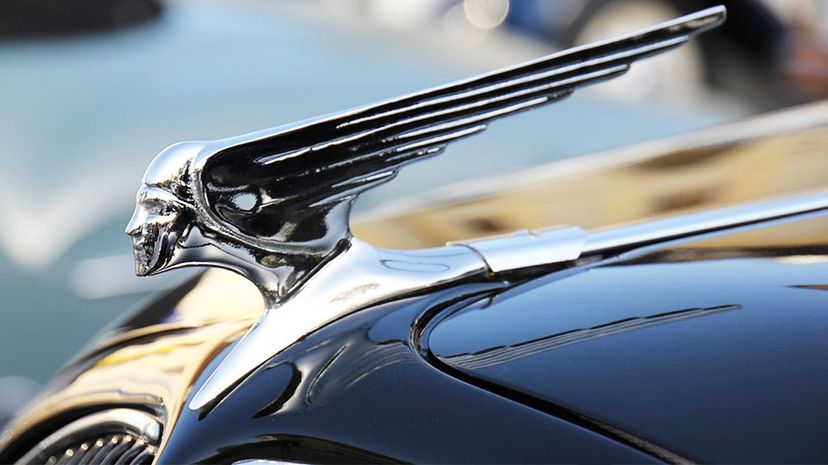
Citroen's Five Horses mascot from the '20s was crafted by glassmaker Rene Lalique and ranks among the most famous hood ornaments ever made. In the '30s, the company began adding a Flying Goddess design to its popular Traction Avant four-door. Various incarnations of the design continued to adorn the vehicle through the '50s, including many with sharply pointed wings extending like daggers behind the figure's head.

Named for Henry Ford's son, Edsel was a heavily-promoted lined of cars produced by Ford and released in 1958. Unfortunately, buyers found them ugly and expensive, leading to sluggish sales. Because the line was discontinued after 1960, examples of the Edsel hood ornament, with its stylized E set in a plastic insert surrounded by a thick chrome ring can be hard to come by.
Advertisement

Hudson introduced its sleek, compact Jet in 1953 to take on the briskly-selling Nash Rambler. While Hudson produced this car for only two years before merging with its rival Nash, the Jet is remembered not only for its cool name but for its cool jet plane hood ornament, which was both classic and futuristic in its clean, minimal styling.
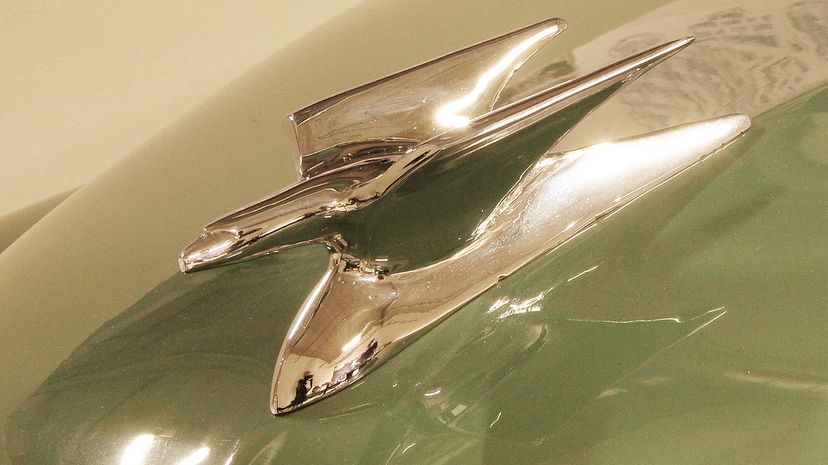
American automaker Crosley produced a range of extra-small compact vehicles from the late '30s through the early '50s. The company coined the term "sport utility wagon" in 1947, and the next year began placing a bird ornament on the hoods of many of its car and truck models. Crosley went out of business in 1952 but had one more surge of success before then with its stylish wood-paneled station wagons.

It seems only fitting that Pierce-Arrow would choose this stunning archer figure to ride on the hood of its coveted luxury cars. The design was in use from 1900 through the beginning of the 1940s, with ornaments ranging from sleek chrome creations to bronze figures with more muscles than a Renaissance sculpture.
Advertisement

Ford's luxury Lincoln line shot to fame in the '40s thanks to brisk sales of the Continental. Starting in 1956 with the Lincoln Mark II, the company began to use a four-pointed star ornament on the hood. While it has gotten narrower and changed designs over the years, the four-pointed star remains a Lincoln signature half a century later.

French manufacturer Peugeot began selling steel in 1810, and by 1850, was using its iconic lion mascot on saw blades and tools. The Peugeot lion first appeared on a car in the 1920s, though its most impressive 3D iterations came between the 1930s and 1950s. By the second half of the 20th century, the company had changed to a flat lion emblem for safety.

Duesenberg was one of the top names in automotive luxury in the early 20th century. Best known today for its large, powerful and elegant Model J, the company was defunct by the '40s. Its early eagle profile emblems were transformed into a sharp and deadly eagle figurine in the Model J, with wings and beak sharp enough to scare even the bravest pedestrians.
Advertisement

British company Humber made entry-level luxury cars in the form of its Snipe and Super Snipe models from the '30s through the '60s. Appropriately enough, a chrome model of the snipe bird appeared above the hood. Elongated with pointed wings, its metal beak was eventually changed to one made from rubber to prevent pedestrians from being impaled.

Tail fins first appeared on Cadillacs in the late '40s and reached peak size in the late '50s. The fins were so popular that the company eventually dumped its winged woman mascot in favor of a pair of chrome fins in the center of the hood. As fins went out of style in the '60s, the company eventually switched to a more refined emblem-style ornament.